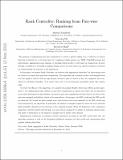Rank Centrality: Ranking from Pairwise Comparisons
Author(s)
Negahban, Sahand; Oh, Sewoong; Shah, Devavrat
DownloadShah_Rank Centrality.pdf (567.5Kb)
OPEN_ACCESS_POLICY
Open Access Policy
Creative Commons Attribution-Noncommercial-Share Alike
Terms of use
Metadata
Show full item recordAbstract
The question of aggregating pairwise comparisons to obtain a global ranking over a collection of objects has been of interest for a very long time: be it ranking of online gamers (e.g., MSR’s TrueSkill system) and chess players, aggregating social opinions, or deciding which product to sell based on transactions. In most settings, in addition to obtaining a ranking, finding ‘scores’ for each object (e.g., player’s rating) is of interest for understanding the intensity of the preferences.
In this paper, we propose Rank Centrality, an iterative rank aggregation algorithm for discovering scores for objects (or items) from pairwise comparisons. The algorithm has a natural random walk interpretation over the graph of objects with an edge present between a pair of objects if they are compared; the score, which we call Rank Centrality, of an object turns out to be its stationary probability under this random walk.
To study the efficacy of the algorithm, we consider the popular Bradley-Terry-Luce (BTL) model (equivalent to the Multinomial Logit (MNL) for pairwise comparisons) in which each object has an associated score that determines the probabilistic outcomes of pairwise comparisons between objects. In terms of the pairwise marginal probabilities, which is the main subject of this paper, the MNL model and the BTL model are identical. We bound the finite sample error rates between the scores assumed by the BTL model and those estimated by our algorithm. In particular, the number of samples required to learn the score well with high probability depends on the structure of the comparison graph. When the Laplacian of the comparison graph has a strictly positive spectral gap, e.g., each item is compared to a subset of randomly chosen items, this leads to dependence on the number of samples that is nearly order optimal.
Experimental evaluations on synthetic data sets generated according to the BTL model show that our algorithm performs as well as the maximum likelihood estimator for that model and outperforms other popular ranking algorithms.
Date issued
2016-10Department
Massachusetts Institute of Technology. Department of Electrical Engineering and Computer Science; Massachusetts Institute of Technology. Laboratory for Information and Decision SystemsJournal
Operations Research
Publisher
Institute for Operations Research and the Management Sciences (INFORMS)
Citation
Negahban, Sahand, Sewoong Oh, and Devavrat Shah. “Rank Centrality: Ranking from Pairwise Comparisons.” Operations Research 65, 1 (February 2017): 266–287 © 2017 Institute for Operations Research and the Management Sciences (INFORMS)
Version: Original manuscript
ISSN
0030-364X
1526-5463